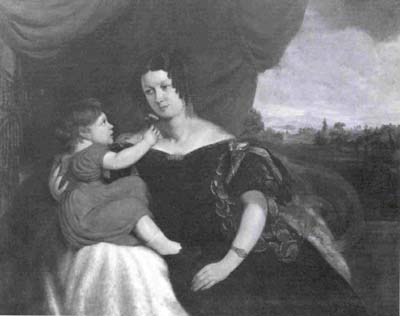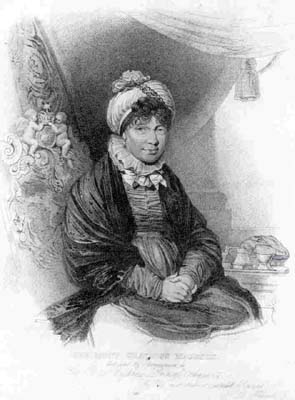
Annual Bulletin 8, 1984-1985
Home
Français
Introduction
History
Annual Index
Author &
Subject
Credits
Contact


Henry D.
Thielcke: A recently Found
Portrait and some Reflections on
Thielcke's Links with the English School
by Ross Fox
Résumé en français
Pages 1 | 2 |
3 | 4 |
5 | 6
In 1981 the National Gallery of Canada acquired a portrait by Henry
Daniel Thielcke (c. 1788 / 89-1874) of such calibre as to offer an altogether
new insight into the nature of Thielcke's artistic accomplishment (fig. 1). (1) By
itself, the painting is sufficient to excite a reassessment of
this little-studied artist. In a broader art-historical perspective, it
also constitutes a superb example of the overt transmission to Lower Canada
of current English taste, of a semi-sophisticated order, in large-scale
portrait painting.
Much of both Thielcke's life and
his oeuvre remains unknown. Gérard Morisset has written the only
significant passages on this artist, though misleadingly calling him
a "peintre arméricain." (2) Foremost an English artist, in the latter
half of his life Thielcke passed about two decades in Lower Canada and
another two in the United States.
Of presumed recent German ancestry,
Thielcke was born at St. James's Palace about 1788/89. (3) His father is thought
to have been the "Thielche" who was a groom of the bed-chamber to His
Majesty George III. His mother was a woman of the bed-chamber to Queen
Charlotte. They are mentioned in the diary of Lady Charlotte Bury (1775-1861)
as having a son who was a miniaturist. (4) Henry Daniel Thielcke did paint
portrait miniatures throughout much of his life, in addition to history
paintings and large portraits, and he was an engraver as well. Also, for
many years he kept ties with personages in the royal entourage, and at
least from 1805 until 1813 his address was the Queen's House (later known
as Buckingham Palace), by that time the principal residence of the royal
family. (5)
Thielcke would seem to have had the benefit of an advantageous training.
Records show that he entered the British Academy
Schools on 4 January 1806, when seventeen years of age; he is said also
to have been a pupil of Sir Thomas Lawrence. (6) Thielcke exhibited with some
regularity at the Royal Academy of Arts from 1805 unti1 1816, in which
body he held the rank of Perpetual Student, and at the British Institution
in 1811, 1815, and 1816. (7) Outside these passing mentions, little is known
of his artistic formation and early work.
The British Museum is in possession of several engravings by Thielcke from
his early period: (8) the best known is a portrait of Queen Charlotte, published
2 December 1818 by Colnaghi & Co. just after the queen's death on 17
November (an impression of this engraving is also in the McCord Museum,
Montreal; fig. 2). Made after a portrait painted by Henry Edridge in 1814,
the engraving has been simplified and abbreviated, with full attention
given to the three-quarters-length figure (the queen was shown full-length
in the original painting). (9) Thielcke also painted Queen Charlotte; in
the early part of this century there was a canvas by him in the royal
collections at Frogmore House, in which he borrowed the pose of Edridge,
substituting a new setting and attire. (10)
Of the several other painted portraits
by Thielcke that are documented from his English period, only one concerns
a sitter from the royal entourage. It is "The Rev. Mr. Kuper,"
which was exhibited at the Royal Academy in 1807: (11) William Kuper, D. D.,
was chaplain to George III and later to Queen Adelaide. It can be
surmised that other portraits of a comparable patronage must have been
executed, through Thielcke's connection with the Duchess of York.
In the lower right corner of his
engraving of Queen Charlotte, Thielcke designated himself "Portrait Painter
to HRH the Duchess of York" - a title that he made much use of, especially
in his later Canadian years. The date of his entry into the service of
the duchess is uncertain, but it seems he retained this appointment until 1820,
when she died. Thielcke's supposed German heritage and his proficiency
in the German language could only have been assets in that regard. Princess
Frederica Charlotte Ulrica Catherina (b. 7 May 1767), Duchess of York,
was the eldest daughter of Frederick William II, King of Prussia. In 1791
she married Frederick Augustus, Duke of York and Albany, the second son
of George III and Queen Charlotte. Their marriage was not especially blissful
and, typical of the times, there were recurrent whisperings of paramours
and improper conduct (detractions that were, however, endemic to persons
of their station).
The princess demonstrated a strong partiality
for privacy, as she spent much of her life in seclusion at her country
estate of Oatlands Park, Surrey, where she devoted herself to the care of innumerable pets.
Joseph Farington records in his diary on 8 June 1794:
A fire happened at Oatlands yesterday which damaged some of the art buildings. The king had been there, and brought back a little dog belonging to the Duchess of York, who seemed more anxious abt. her animals than abt. the house. She has 18 dogs. The king observed that affection must rest on something. When there were no children animals were the objects of it. (12)Little would seem to have changed by 1818, when another visitor wrote:
The Duchess's life is an odd one; she seldom has a female companion, she is read to all night and falls asleep towards morning, and rises about 3; feeds her dozens of dogs and her flocks of birds, &c., comes down two minutes before dinner, and so round again. (13)Thielcke's association with the Duchess of York gives one some idea of the artistic milieu in which he must have worked. Two other artists are known to have been in the service of the duchess: Henry Bernard Chalon (1771-1849) and William Marshall Craig (active 1786-1828).
Next Page | Chalon favoured by royalty and aristocrats
1 | 2 | 3 | 4 | 5 | 6
Annual Index | Author & Subject | Credits | Contact
This digital collection
was produced under contract to Canada's Digital Collections program,
Industry Canada.
"Digital
Collections Program, Copyright
© National Gallery of
Canada 2001"